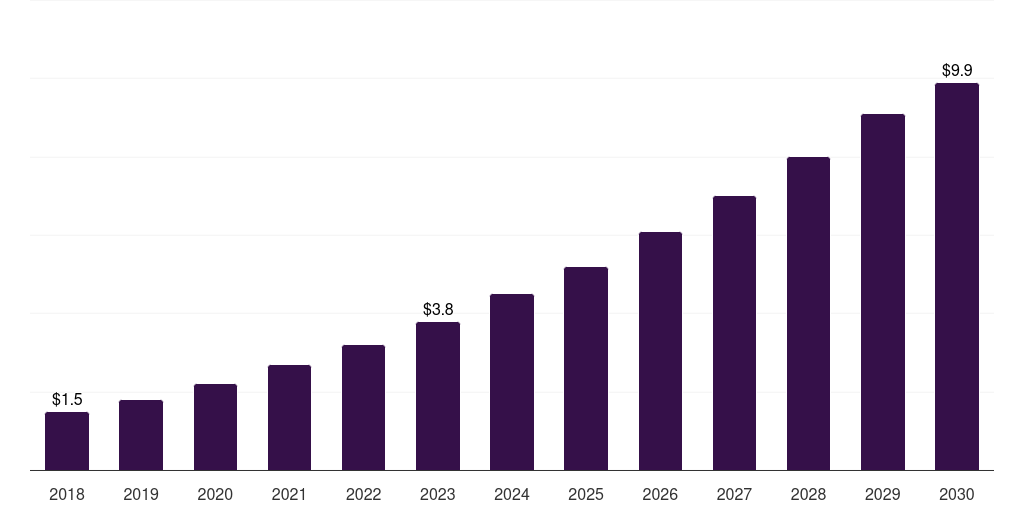UK 3d Printed Drugs Market Size & Outlook, 2023-2030
UK 3d printed drugs market, 2018-2030 (US$M)

Related Markets
UK 3d printed drugs market highlights
- The UK 3d printed drugs market generated a revenue of USD 7.5 million in 2023 and is expected to reach USD 18.9 million by 2030.
- The UK market is expected to grow at a CAGR of 14% from 2024 to 2030.
- In terms of segment, neurology was the largest revenue generating application in 2023.
- Orthopedic is the most lucrative application segment registering the fastest growth during the forecast period.
3d printed drugs market data book summary
| Market revenue in 2023 | USD 7.5 million |
| Market revenue in 2030 | USD 18.9 million |
| Growth rate | 14% (CAGR from 2023 to 2030) |
| Largest segment | Neurology |
| Fastest growing segment | Orthopedic |
| Historical data | 2018 - 2022 |
| Base year | 2023 |
| Forecast period | 2024 - 2030 |
| Quantitative units | Revenue in USD million |
| Market segmentation | Dental, Orthopedic, Neurology |
| Key market players worldwide | GlaxoSmithKline, Hewlett Packard Enterprise Co, Merck KGaA, AstraZeneca PLC, Aprecia Pharmaceuticals, Extend Biosciences, BioDuro, Affini-T Therapeutics, Osmotica Pharmaceutical, FabRx, Cycle Pharmaceuticals |
Other key industry trends
- In terms of revenue, UK accounted for 7.3% of the global 3d printed drugs market in 2023.
- Country-wise, U.S. is expected to lead the global market in terms of revenue in 2030.
- In Europe, Germany 3d printed drugs market is projected to lead the regional market in terms of revenue in 2030.
- Germany is the fastest growing regional market in Europe and is projected to reach USD 23.2 million by 2030.
No credit card required*
Horizon in a snapshot
- 30K+ Global Market Reports
- 120K+ Country Reports
- 1.2M+ Market Statistics
- 200K+ Company Profiles
- Industry insights and more
3D Printed Drugs Market Scope
3D Printed Drugs Market Companies
| Name | Profile | # Employees | HQ | Website |
|---|
UK 3d printed drugs market outlook
The databook is designed to serve as a comprehensive guide to navigating this sector. The databook focuses on market statistics denoted in the form of revenue and y-o-y growth and CAGR across the globe and regions. A detailed competitive and opportunity analyses related to 3d printed drugs market will help companies and investors design strategic landscapes.
Neurology was the largest segment with a revenue share of 50.67% in 2023. Horizon Databook has segmented the UK 3d printed drugs market based on dental, orthopedic, neurology covering the revenue growth of each sub-segment from 2018 to 2030.
UK's advanced medical research infrastructure and growing focus on healthcare innovation are among the factors expected to boost 3D printed drugs market growth. The country is home to world-renowned universities and research institutions that are actively researching and developing 3D printing technology for pharmaceutical applications.
Institutions such as the University of Nottingham and the University of East Anglia have made significant progress in the 3D printing of drug delivery systems. In addition, companies such as FABRX LTD. are headquartered in London, which further boosts the country’s share in the market. FABRX is a spin-out company of University College London, which was established in 2014.
Furthermore, the country’s government funding and support for innovative healthcare technologies, including 3D printing, fuel the growth of the 3D printed drugs market. However, regulators and applicants have numerous difficulties due to the complexity of the UK & European Union (EU) regulations and regional challenges regarding safety, scalability, & dependable production, which may restrain market expansion.
Reasons to subscribe to UK 3d printed drugs market databook:
-
Access to comprehensive data: Horizon Databook provides over 1 million market statistics and 20,000+ reports, offering extensive coverage across various industries and regions.
-
Informed decision making: Subscribers gain insights into market trends, customer preferences, and competitor strategies, empowering informed business decisions.
-
Cost-Effective solution: It's recognized as the world's most cost-effective market research database, offering high ROI through its vast repository of data and reports.
-
Customizable reports: Tailored reports and analytics allow companies to drill down into specific markets, demographics, or product segments, adapting to unique business needs.
-
Strategic advantage: By staying updated with the latest market intelligence, companies can stay ahead of competitors, anticipate industry shifts, and capitalize on emerging opportunities.
Target buyers of UK 3d printed drugs market databook
-
Our clientele includes a mix of 3d printed drugs market companies, investment firms, advisory firms & academic institutions.
-
30% of our revenue is generated working with investment firms and helping them identify viable opportunity areas.
-
Approximately 65% of our revenue is generated working with competitive intelligence & market intelligence teams of market participants (manufacturers, service providers, etc.).
-
The rest of the revenue is generated working with academic and research not-for-profit institutes. We do our bit of pro-bono by working with these institutions at subsidized rates.
Horizon Databook provides a detailed overview of country-level data and insights on the UK 3d printed drugs market , including forecasts for subscribers. This country databook contains high-level insights into UK 3d printed drugs market from 2018 to 2030, including revenue numbers, major trends, and company profiles.
Partial client list
UK 3d printed drugs market size, by application, 2018-2030 (US$M)
UK 3D Printed Drugs Market Outlook Share, 2023 & 2030 (US$M)
Related industry reports
Related regional statistics
Sign up - it's easy, and free!
Sign up and get instant basic access to databook, upgrade
when ready, or enjoy our
free plan indefinitely.
Included in Horizon account
- 30K+ Global Market Reports
- 120K+ Country Reports
- 1.2M+ Market Statistics
- 200K+ Company Profiles
- Industry insights and more



